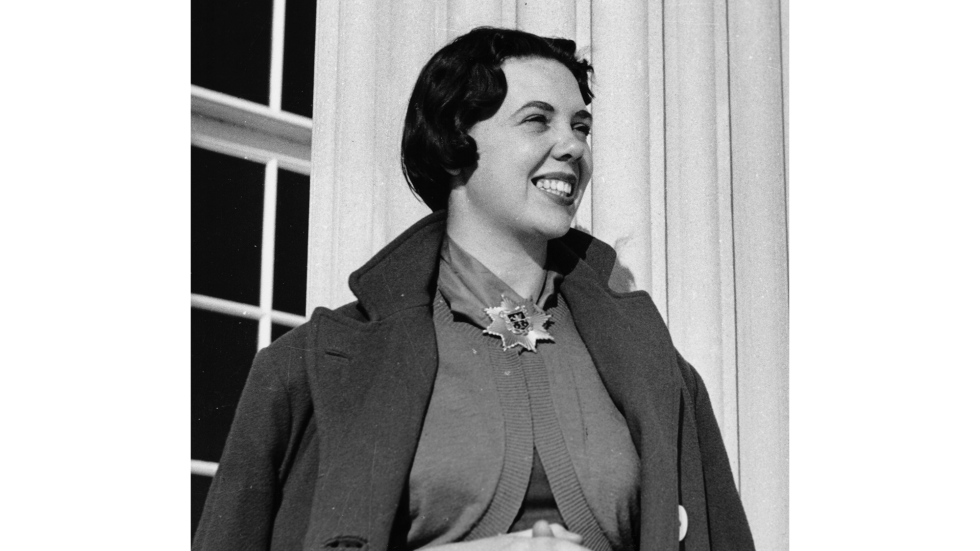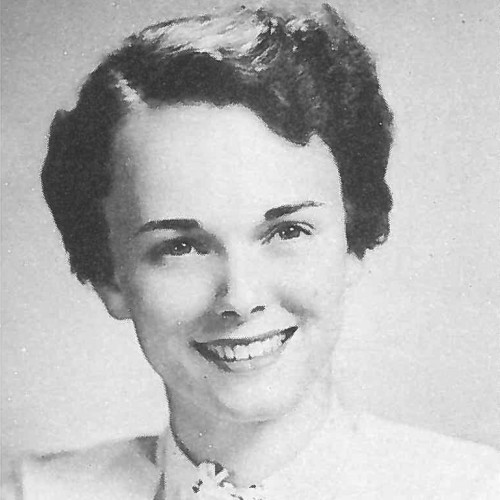
Entering as a transfer student in 1951, Luice Moncey ’53 was the first woman to graduate from Stonehill.
Seventy Years of Women at Stonehill
In 1951, Stonehill admitted 19 women and became a coeducational college. SAM shares some milestones for women at Stonehill throughout the decades.
When Dona (McManus) Scandura ’55 was a sophomore in high school, her mother wrote a letter to Stonehill President George Benaglia, C.S.C., asking when women would be able to attend the small college in Easton, her family’s hometown. He responded that they would consider it in a few years. By the time Scandura graduated from high school in 1951, she was among the first 19 women who would attend Stonehill that fall.
“I still have the letter,” Scandura said during her oral history session with the Stonehill Archives at her 50th Reunion. “I applied to Stonehill College and several others and got accepted. I chose my hometown because I loved the atmosphere. It was wonderful.”
Admitting women was big news. The front page of the May 4, 1951 edition of The Summit read, “Announcement of Coeducational Program Inaugurates New Era.” The article noted that President Francis Boland, C.S.C. “released to the press a momentous decision that will rank high in the history of the college.”
Behind this decision was the College’s financial situation. In the summer of 1950, the U.S. entered the Korean War. With more men being drafted, colleges around the country faced dwindling numbers of male applicants. Stonehill, still in its infancy and dependent upon tuition, could not afford a decline in its enrollment. As Rev. Richard Gribble, C.S.C. writes in Fulfilling a Dream, Stonehill College 1948-1998, “The presence of coeds at Stonehill was directed not by the spirit of justice but by world events, when the reality of need and survival triumphed over the staid traditionalism of all-male Catholic colleges.”
The women who arrived at Stonehill included 17 first-year students, one sophomore and one junior. They majored in biology, English, history/government and economics.
Many commuted from their family homes, and some lived in College-approved, local residences.
The Standard Times reported on the start of the school year in an article dated September 18, 1951, noting President Boland’s “warm welcome to the young women, urging them to ‘feel at home.’” It also pointed out that Stonehill was the second Catholic college in New England to become coeducational, with Merrimack College having admitted women students the previous year.
Luice Moncey ’53 was the junior; she had transferred from the University of Massachusetts. Remembering her first experience at Stonehill, she said during her oral history, “Because I was in all junior classes, I walked in, and there were no other girls, and there were a lot of black robes, you know. The novitiates were there, too. I went home and said to my mom, ‘There were no girls. And I’m with a priest. And I’m taking logic. And ethics and everything with priests there.’” Moncey became the first woman to graduate from Stonehill.
I applied to Stonehill College and several others and got accepted. I chose my hometown because I loved the atmosphere. It was wonderful.
According to Stonehill Archivist Nicole (Tourangeau) Casper ’95, to prepare for the arrival of women students, the College converted the pool in what is now Alumni Hall into bathroom facilities. The existing student lounge in that building became coeducational and the upstairs area became a student lounge for women.
As they enrolled in classes, the women also started to change the campus culture—from sports and clubs to dormitories and course offerings. Here, SAM shares some milestones throughout the decades for women at Stonehill.
1950s
ON THE COURT
According to Fulfilling a Dream, a coeducational basketball team played three games in the early ‘50s. In 1959, guided by the dean of women Virginia Yosgandes, a formal women’s basketball team was created. Later, in 1962, the first director of women’s athletics was hired, Nancy Carroll, and Stonehill joined the Greater Boston Women’s Basketball League.
WRITING FOR THE SUMMIT
Ellen (Flaherty) Tennihan ’55 became the editor of The Summit.
NEW STUDENTS
In the fall of 1951, 19 women were admitted to Stonehill. Luice Moncey ’53, who transferred to Stonehill in her junior year, was the College’s first female graduate. Margaret (Mullaney) Panos ’54, the only woman student in the Class of 1954, delivered the valedictory address at the June 6, 1954, Commencement.
IN THE CLASSROOM
Mary Elizabeth Reeves served as the College’s first dean of women and was also an instructor of English. Assistant Professor of Chemistry Maryalice Moore [above] was the first female faculty member with a Ph.D.
THE CROSIERS
In her oral history, Dona (McManus) Scandura ’55 recalls being a member of The Crosiers Club, running up the stairs of what is now Alumni Hall to attend meetings on the second floor. Organized for women, the club coordinated the athletic, social and religious activities of coed life.
1960s
CURFEW, PANTS, DORM COUNCIL
According to The Summit from September 20, 1967, the new dean of women, Karen Haskell, lifted curfew restrictions for senior women living off campus. Haskell remarked, “A senior woman is an adult and assumes complete responsibility for herself.” She also eased up on the dress regulations, allowing “slacks” to be worn at all meals on Saturday and the evening meal on Sunday.
In the article, Haskell also announced that a dorm council would be set up in the women’s dormitory since “women themselves should be allowed to run their dorm and decide their own policies.”
BOARD MEMBER
The Honorable Beatrice Mullaney was the first woman trustee. She served from 1962 to 1979.
A DORM FOR WOMEN
Boland Hall, a dormitory for women, was built in 1967. According to an article in The Summit from March 22, 1967, “the rooms are set in a staggered pattern, avoiding the stale uniformity of the men’s dorm.” The dorm was named for former president Rev. Francis Boland, C.S.C., in honor of his role in admitting women to Stonehill.
GIVING BACK
Later in the ’60s, women students formed the Donataire Society, a new service organization on campus.
1970s
BASKETBALL
The College reintroduced women’s basketball, after it was discontinued, in 1963. Paula Sullivan was hired as the women’s basketball coach in 1971 and then became the athletic director in the early ’90s.
WOMEN’S GROUP
A Summit article from October 31, 1979, highlights the Women’s Group on campus, noting, “Their interests include seeking improvements in the cafeteria, considering pertinent political questions and raising the consciousness of women in regard to themselves and others.”
1980s
COURSE WORK
Women’s studies courses were incorporated into the new General Studies Program.
FOCUS ON SPORTS
In the late ’70s and early ’80s, a task force recommended that more female athletes receive scholarships. In 1979, women’s soccer and volleyball teams were established. Women’s basketball excelled, with conference championships in 1983, 1985 and 1987.
1990s
CENTER FOR WOMEN
According to Fulfilling a Dream, the Maryalice Conley Moore Center was established in 1994 to “increase campus awareness of such issues as sexual assault, sexual harassment, career options, age and gender bias, safety and diversity.” The Center was named in honor of Professor of Chemistry Maryalice Conley Moore, who was a pioneer in her field. Jean Hamler, who served as the first director of Intercultural Affairs and helped establish the Center, recalls, “Programming initiatives were student led. The center was open to all women on campus and welcomed input from students, faculty and staff.”
TEAMS AND CHAMPIONSHIPS
Field hockey and women’s lacrosse teams held inaugural seasons in the mid-1990s. Women’s tennis won the NE-10 crown. Women’s basketball competed in the NCAA Elite Eight in both 1994 and 1995.
CLUB ACTIVITY
To further explore women’s issues, a student club, the Organization for the Study of Gender Issues, was formed.
2000s to Present
GENDER EQUITY
The Moore Center found a home in the Student Union building and later moved to the Martin Institute and then Duffy Hall. Renamed the Moore Center for Gender Equity, the center hosts programs throughout the year and is open to students of all gender identities.
ATHLETICS CONTINUES TO GROW
Under Coach Karen Boen, women’s cross country and track and field won 19 Northeast-10 Conference championships across the three programs. The 2003 equestrian team won its first national title in the IHSA Hunter Seat/Collegiate Cup. In 2003 and 2005, the women’s lacrosse teams were NCAA Division II national champions. Women’s golf, swim and ice hockey teams are established.
COURSEWORK
Taught by Associate Professors of History Linzy Brekke-Aloise and Karen Teoh, a Learning Community, the Global Struggle of Female Education, examines the roles of gender, race, politics and religion in the global effort for female educational civil rights.
MENTORSHIP IN FINANCE
Part of the Stonehill College Inspire Finance Initiatives program, LAUNCH, a mentorship program for first and second year women interested in finance, was started. This led to the creation of the Women in Finance club.
CAMPUS ACTIVITIES
Student groups and clubs that focus on the interests of and opportunities for women are active on campus, including Women’s Health and Empowerment NOW (WHEN), R.I.S.E. (Radiant Inspirational Sisters Empowered), Her Campus, She’s the First at Stonehill, Women in STEM and Girls from the Hill [photo above].
FORUMS AND SUMMITS
In 2018, the inaugural Alumnae Summit took place, a half-day conference providing opportunities for alumnae to connect and build a network of support [photo above]. Stonehill has also hosted a Summit on Women’s Leadership and Social Justice Matters.
Information for this article obtained from the Stonehill Archives and Fulfilling a Dream: Stonehill College 1948-1998.
Stonehill Alumni Magazine
Summer | Fall 2021

